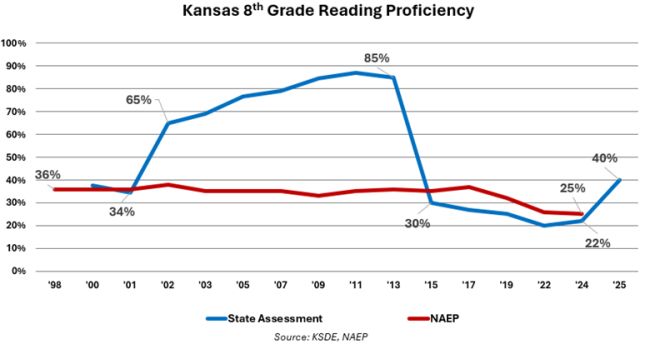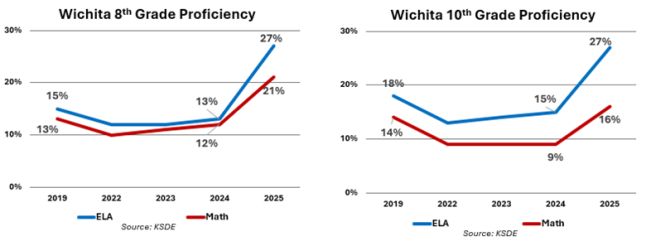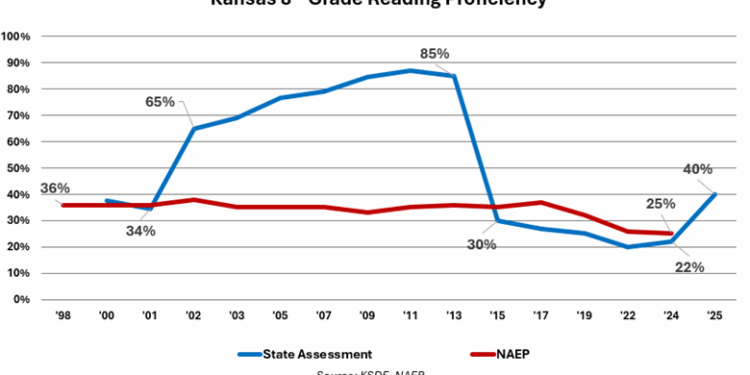In the fable of the Emperor’s New Clothes, two con men convinced the Emperor they had woven a magnificent set of clothes that were invisible to incompetent people. Everyone went along with the ruse to avoid being considered stupid, but they knew he was naked. A similar con is being pulled by the Kansas State Board of Education and the Kansas Department of Education (KSDE). They reduced proficiency standards earlier this year, and now parents are being told that reading and math proficiency have miraculously improved over last year.
This year’s bogus gains are not part of an upward trend. For example, high school reading proficiency was steadily in the mid-20s over the last four years, but it jumped to 38% this year. High school math proficiency was consistently in the low-20s, yet you’re expected to believe it suddenly skyrocketed to 34% without changing the standard that determines proficiency.
It’s like changing the grading scale on a test from 90 to 100 for an “A” to 70 to 100; there will be a lot more As recorded, but it doesn’t mean students are doing better.
This isn’t the first time the State Board of Education reduced standards to artificially improve outcomes; proficiency nearly doubled when they did it in 2002. No Child Left Behind called for 100% of students to be proficient by 2014, but Congress let states devise their own proficiency standards, and most, including Kansas, dumbed them down.
When NCLB went away, Kansas went back to having high standards that paralleled national proficiency standards in 2015, and 8th-grade reading proficiency plummeted from 85% to 30%. That’s pretty much in line with national results for Kansas on the “gold standard” NAEP exam. Students didn’t suddenly forget how to read; State Board of Education members merely decided to end the deception.

Fast forward to today, and you are also expected to believe that district-level results bizarrely improved.
Lower proficiency standards lead to bogus district results
In USD 259 Wichita, proficiency in 8th-grade reading (English Language Arts) more than doubled, going from 13% to 27%, and math proficiency jumped from 12% to 27%.

In Shawnee Mission, 8th-grade reading and math proficiency leaped from 33% to 54%. In Lawrence, reading proficiency went from 24% to 46%, and in Lansing, math proficiency allegedly spiked from 21% to 43%. Topeka shot up from 14% to 25%.
Teachers worked as hard last year as they did in prior years. Nothing changed across Kansas last year except this: the Kansas Department of Education changed the test, and the State Board of Education rubber-stamped lower proficiency standards.
The deception perpetrated on parents is bad enough. The real tragedy is that a lot of students will be misled into thinking they are academically ready for life after high school.
Two years ago, the Kansas Legislature passed the Blueprint for Literacy, which called for reading and math proficiency to go from about 33% to 50% by 2033 without changing standards. The State Board and KSDE essentially said, “Bugger off. We don’t care what laws you pass or whether parents can honestly track student progress. We’ll do what makes us look good.”
Now, legislators must decide whether to be pushed around by the State Board of Education or exercise their legal authority to reject the low standards and reinstate the previous test and proficiency standards.
The teacher unions, the superintendents’ association, and other political interests will threaten to remove legislators from office if they do so, and that strikes fear in the hearts of many Republican legislators. But threats from the bureaucracy must be set aside to ensure that Kansas students get the education they deserve.
Here’s hoping enough legislators have the courage to admit that the Emperor is naked.










